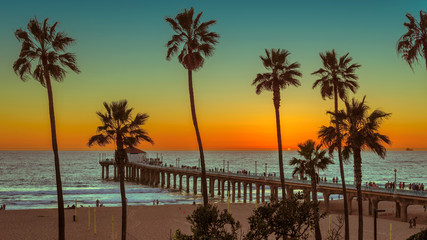The history of California can be divided into the Native American period (about 10,000 years ago until 1542), the European exploration period (1542–1769), the Spanish colonial period (1769–1821), the Mexican period (1821–1848), and United States statehood (September 9, 1850–present). California was one of the most culturally and linguistically diverse areas in pre-Columbian North America. After contact with Spanish explorers, many of the Native Americans died from foreign diseases. Finally, in the 19th century there was a genocide by United States government and private citizens, which is known as the California genocide.[1]

The California Gold Rush of 1848–1855 attracted hundreds of thousands of ambitious young people from around the world. Only a few struck it rich, and many returned home disappointed. Most appreciated the other economic opportunities in California, especially in agriculture, and brought their families to join them. California became the 31st U.S. state in the Compromise of 1850 and played a small role in the American Civil War. Chinese immigrants increasingly came under attack from nativists; they were forced out of industry and agriculture and into Chinatowns in the larger cities. As gold petered out, California increasingly became a highly productive agricultural society. The coming of the railroads in 1869 linked its rich economy with the rest of the nation, and attracted a steady stream of settlers. In the late 19th century, Southern California, especially Los Angeles, started to grow rapidly.

The Spanish divided California into two parts, Baja California and Alta California, as provinces of New Spain (Mexico). Baja or lower California consisted of the Baja Peninsula and terminated roughly at San Diego, California, where Alta California started. The eastern and northern boundaries of Alta California were very indefinite, as the Spanish, despite a lack of physical presence and settlements, claimed essentially everything in what is now the western United States.

The first permanent mission in Baja California, Misión de Nuestra Señora de Loreto Conchó, was founded on October 15, 1697, by Jesuit priest Juan Maria Salvatierra (1648–1717) accompanied by one small boat's crew and six soldiers. After the establishment of Missions in Alta California after 1769, the Spanish treated Baja California and Alta California, known as Las Californias, as a single administrative unit with Monterey as its capital, and falling under the jurisdiction of the Viceroyalty of New Spain based in Mexico City.

After 1900, California continued to grow rapidly and soon became an agricultural and industrial power. The economy was widely based on specialty agriculture, oil, tourism, shipping, film, and after 1940 advanced technology such as aerospace and electronics industries – along with a significant military presence.